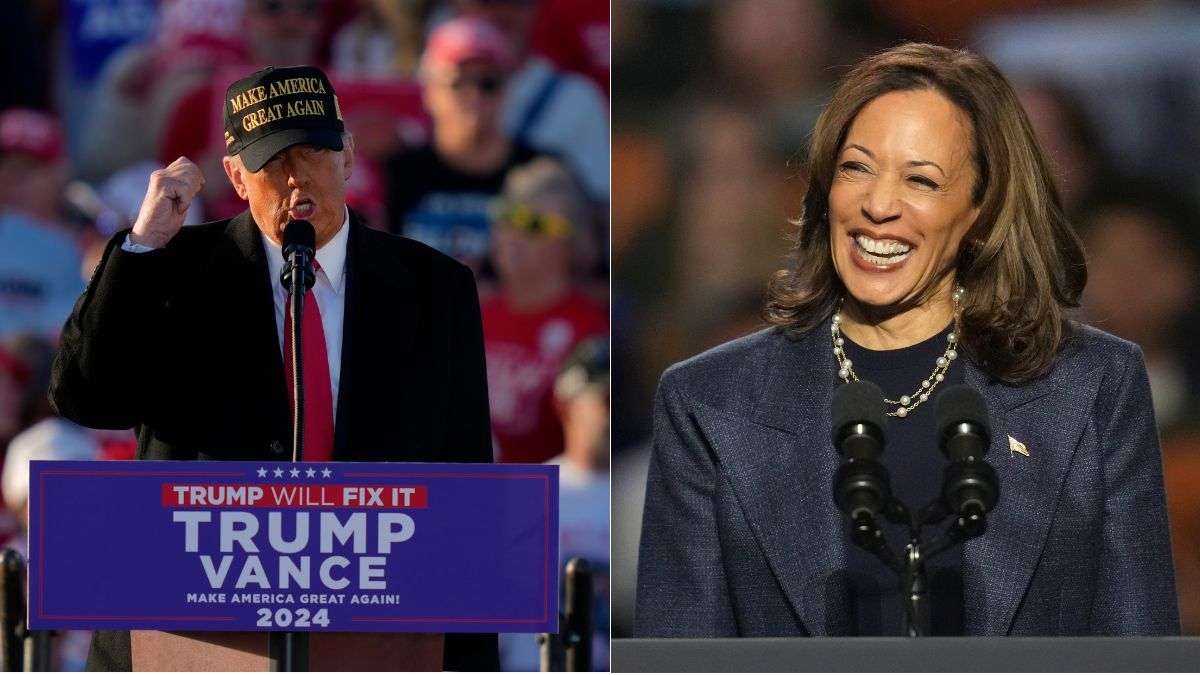
International: On election eve in the United States, the presidential race is deadlocked. The polls are exceptionally close across the country and in all the swing states – Pennsylvania, Michigan, Wisconsin in the industrial midwest; Nevada and Arizona in the west; and Georgia and North Carolina in the south. The final New York Times/Siena poll shows Democratic Vice President Kamala Harris leading by a very small margin or tied with Republican former President Donald Trump in all the swing states. The exception is Arizona, where Trump leads by a few percentage points. While there is no clear favourite to win, there are several critical factors that will be driving voters’ decisions on Election Day. This is what to watch.
Republicans turning against Trump
Trump’s favourability is stuck around 43 per cent in nationwide polling. In the past two presidential elections, he fell short of taking 50 per cent of the national popular vote. As president, he never achieved over 50 per cent favourability. And he has never topped 50 per cent since leaving office. This means he has hit a ceiling in his support and is highly unlikely to win the national popular vote on Tuesday. This also reflects what happened to Trump in the Republican primaries to win the nomination. He dominated the field, defeating Florida Governor Ron DeSantis, former UN Ambassador Nikki Haley, and several others. But in most of those primaries, 15-20 per cent of Republican voters did not vote for Trump.
Where will these Republican voters ultimately land on Tuesday? Probably half want to vote Republican and will go with Trump. Others will not be able to bring themselves to vote for Harris and will simply not vote for president. Others will switch their support to Harris. Indeed, there has never been such a swelling of support from members of one party to support the other party’s presidential candidate. Harris needs those “Republicans for Harris” votes. In addition, she’ll need to replicate the coalition of young voters, voters of colour and women who backed current President Joe Biden against Trump in 2020 in those same swing states and nationally.
Her favorability ratings are higher than Trump's, at around 46 per cent. The closer a presidential candidate is to 50 per cent approval ratings, the better their chance of winning the election.
Core issues that could drive US elections
At the same time, the country is in a bad mood. There is a classic polling question asked at elections: is the country on the right track, or moving in the wrong direction? Between 60–70 per cent of Americans believe the country is on the wrong track. That is a signal this election is about change. Historically, that sentiment has not favoured the incumbent in the White House. As Biden’s vice president, Harris is directly facing this headwind.
There are four key issues in this election. The most important is the hip pocket issue: household budgets, cost of living pressures and voters’ concerns about their future economic security. Since Biden and Harris took office nearly four years ago, the cost of groceries, household items, utilities and services such as insurance have risen between 10–40 per cent. Petrol prices have gone up even more. Though interest rates have fallen, American households are hurting. When asked who is best to manage the economy, voters in swing states say Trump by a 15-point margin.
The next biggest issue is immigration. Since Trump first became a presidential candidate in 2015, he has relentlessly pushed the immigration button, declaring the border with Mexico is out of control, with crime and pillage rising in its wake.
The first three years of Biden’s term were also marked by big surges of immigrants crossing the border, though rates have fallen dramatically in 2024. Voters view Trump as best placed to manage this issue, too, by nearly 15 points. So, Trump is seen as a more effective leader on the two most important policy issues in this election.
A surge in support from women
Abortion rights and reproductive health services are the third major issue. Many women across America are repelled by the Supreme Court’s decision to take away their long-held constitutional right to an abortion. Now, this policy is decided at the state level. And several conservative Republican states – including Ohio and Kansas – have voted to restore abortion rights. Harris is seen as the champion of these issues. Multiple polls show voters trust her more than Trump on reproductive rights, by wide margins. As a result, polling shows Harris is leading Trump with women voters in the swing states, by 15 points or more.
Abortion rights are also on the ballot in two swing states, Nevada and Arizona, which should help Harris in both. The future of American democracy is the fourth major issue facing voters. According to a new poll, half the country sees Trump as a profound threat to America’s democracy who will wield authoritarian power to enforce his policies and programmes. Harris has pledged to turn the page, heal divisions and get Republicans and Democrats working together again. In these closing days, Trump continues to make provocative statements with violent imagery. At a rally in Arizona last week, for instance, he again attacked Liz Cheney, the former Republican congresswoman who advocated for the prosecution of Trump over the January 6 insurrection:
She’s a radical war hawk. Let’s put her with a rifle standing there with nine barrels shooting at her, OK? Let’s see how she feels about it. You know, when the guns are trained on her face. This may have provided Harris with a final cut-through moment on Trump’s fitness for office in the final days of the campaign. She said in response: Anyone who wants to be president of the United States who uses that kind of violent rhetoric is clearly disqualified and unqualified to be president. […] Trump is increasingly, however, someone who considers his political opponents the enemy, is permanently out for revenge and is increasingly unstable and unhinged.
Who will win US elections?
Trump’s team sees victory in all the polls. His chief pollster wrote late last week: President Trump’s position nationally and in every single battleground state is significantly better than it was four years ago. The polls may also be undercounting the full measure of Trump’s support, as was the case in 2016 and 2020. And the polls may not be reflecting the extent of antipathy towards Harris as a Black and south Asian woman. Jen O’Malley Dillon, Harris’ campaign director, and who headed the 2020 Biden campaign that defeated Trump, has told her troops, meanwhile, that undecided voters are “gettable”, adding: "We have multiple pathways to victory […] Our folks are voting at levels we need them to vote in order for us to win."
Harris has built a USD 1 billion (AUSD 1.5 billion) machine designed to reach voters in the swing states – through personal contact. This machine made three million phone calls and door knocks on homes in Michigan, Pennsylvania and Wisconsin alone on Saturday. If this machine delivers, it could be the boost Harris needs on election night. Harris’ campaign also signalled over the weekend that late-deciding voters, and especially women, are breaking their way by double digits. There is a sense among Democrats that Harris is now peaking as the campaign concludes.
Final analysis
If Harris wins, it will be because she has successfully sealed the deal with those voters and made the election a referendum on Trump – that on balance the country has had enough of him after eight years. It also means her ground game delivered the votes. If Trump wins, it will mean voters trust him to manage inflation and the cost-of-living squeeze on households, as well as what they see as out-of-control immigration and crime. These messages would also have been further embellished by unease about Harris, a Black and South Asian woman, as president.
--Advertisement--

 Desk
Desk Share
Share






